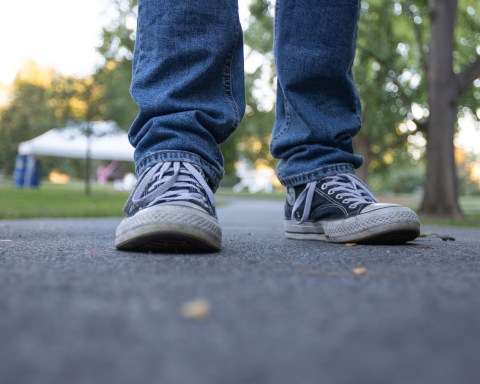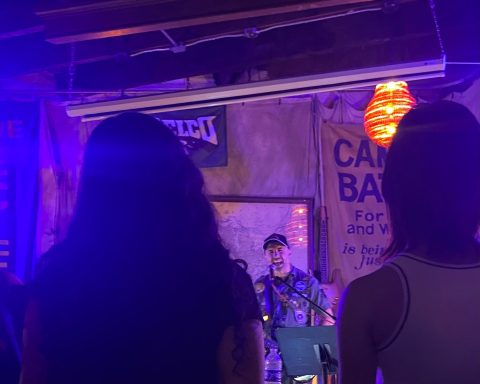Singer Hall, the BEP, that gigantic building looming over campus. Whatever you want to call it, the new academic building has been making headlines at Swarthmore with its name and size. The Lang Foundation, who were one of the primary funders of Singer Hall, decided not to confuse us with yet another Lang center and instead named the building after the Swarthmore alum Maxine Singer ’52, an internationally renowned scientist and winner of the National Medal of Science.
Singer Hall is the second collegiate science building in the country to be named after a woman, which is a big deal for the school. But, before she went on to her fame and success, Maxine Singer was yet another Swarthmore student like all of us are now. It so happens, however, that my grandmother Barbara Searle ’52 was a lifelong friend — and, at times, a rival — to Singer throughout their time at Swarthmore. My grandmother is also a former editor of The Phoenix so I thought it best to tell this story through the very newspaper she managed during her time here.
My grandmother began by talking about the social scene of the school at the time. Believe it or not, there was a curfew at 10:00 p.m. most days and “guests” of other genders were only allowed to visit on Sunday afternoons for two hours at a time. There was also a rule in place that three feet out of the four had to be on the floor, meaning that they couldn’t lie down on beds together or do anything else so utterly scandalous! The Quaker Matchbox was still a thing, and maybe even originated in her time: “An incredible number of people got married, right on graduation” as she remembers it.
There was also only one telephone in the hall: “the poor people who lived at the end of the hall, where the telephone resided, had to answer the phone. And go look for the person who all those guys were looking for, I mean, it was just amazing, how different it was.” These are problems students nowadays cannot relate to in any way, but it’s an interesting story in the lore of the school, and it shows how times have changed and the college with them.
During her time at Swarthmore, my grandmother studied biology, while Singer studied chemistry. During that time at Swarthmore, biochemistry wasn’t yet considered to be an actual field of study, so Singer and Searle ending up taking a lot of overlapping classes despite ending up in different fields. As my grandmother said about their class situation: “Maxine had to take four seminars of chemistry because she was a chemistry major. And I had to take four seminars of biology, because I was a biology major, but we actually shared some of the non-major classes,” and thus formed a friendly rivalry.
Singer and my grandmother also happened to share a common passion for dance. All students were required to take physical education classes, as they are now, and my grandmother began dance classes after breaking one of her fingers in the first meeting of softball. She and Singer were in a few dance productions as chorus members without any special roles. “We wanted to be in the production and we didn’t have any skills to cast us in ‘Ruddigore’ or as dancers,” my grandmother said. There used to be a tradition of performing Gilbert and Sullivan pieces like “Ruddigore” at the school and my grandmother participated in a few of those. They also performed what were then considered Modern dance styles like those of Merce Cunningham and Martha Graham, the latter of the two my grandmother actually trained with!
My grandmother and Singer overlapped in more ways than just academically. Starting with their first year sharing a hall in Parrish, which housed the majority of first years before Willets was built, Singer and Searle got to know each other.
“We [were] taking the same courses …,” my grandmother said. “So then we decided to room together … in our second year, sophomore year.” Ultimately they quit being roommates after sophomore year.
My grandmother continued with the rest of the story: “Then Maxine went on to be more and more and more a biologist, and more and more and more successful. I quit. And literally, I had my excuse at the time … that I was having babies.” After Swarthmore, Searle went on to marry, have two kids, one of whom is my mom, and began a career in education that would eventually lead her to the World Bank. Singer kept working at her passion in biology and through her connections, skills, and while having a few kids of her own made it to where she is now in the field of chemistry.
Looking back, my grandmother commented on her experience and other aspects of her time at Swarthmore that were astonishing. She told me, “in both chemistry and biology, and as far as I can remember, in physics, as well … there was no discrimination, no distinguishing between the men and the women.” My grandmother’s time at Swarthmore was marked by little to none of the patriarchal nature that was common in the era, in her opinion.
After graduation she went on to study at Radcliffe, the Harvard offshoot for women before the school became co-ed, and my grandmother has a diploma that says in Latin that “I have fulfilled all those requirements I would have had to fulfill had I been in student at Harvard.” My grandmother was actively discriminated there, both because of her gender and her path of study, and because of all this, my grandmother has not since donated a penny to Harvard or Radcliffe. She did not have the same resources as men did with their fraternities with old exams and homework, and she wasn’t even allowed access as a graduate student into the main library. She also went so far as to say of her male classmate’s behavior that she had to talk of them “as boys, [for] they were not men” in the way they acted. This behavior felt especially bad for her since “there was nothing like that at Swarthmore ever. And so I didn’t know how I didn’t expect it. And I didn’t know how to deal with it.”
Now as I go take classes in Maxine Singer Hall, I find it funny how small of a world it is and how the past leads convolutedly to the present. I could have never imagined that my family would know anyone important enough to have a building named after them, but, as it turns out, my grandmother believes Maxine Singer to be, “a central part of my [grandmother’s] Swarthmore experience, and [my grandmother] was a central part of her Swarthmore experience.” When relating this story to me, my grandmother summarized that Singer “had a life totally different from mine, as evidenced by the fact that she’s getting building in her name at Swarthmore. And I have nothing like that.” My mom and I who were listening quickly responded about how she had a great family and didn’t really need a building named after her. It was very interesting for me to learn about how Swarthmore was in the past and how much it has changed to bring us to the non-gendered halls and mobile phones. But through that, I now see that that this new building should have a place on Swarthmore campus, and, although BEP is more fun to say, I’ll take pride in calling this new building Singer hall.













